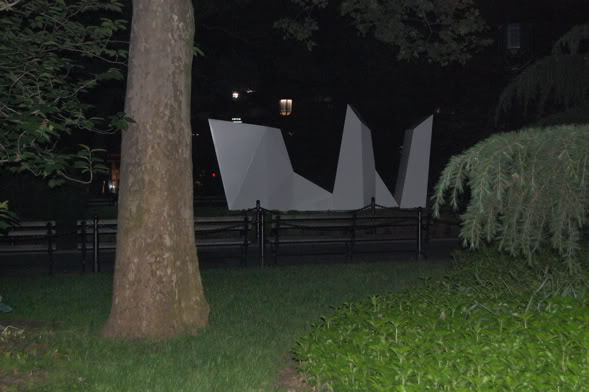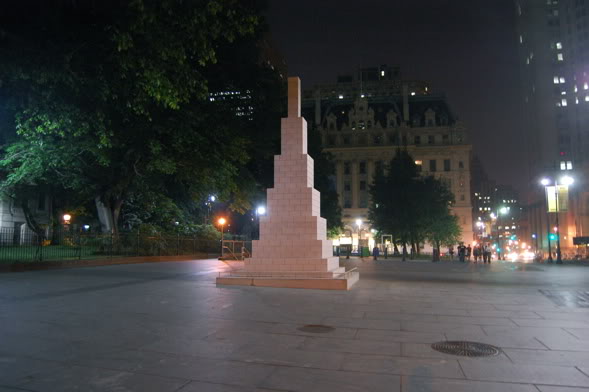Incomplete Open Cubes, 1974. Painted aluminum, various dimensions, roughly 3 ft. 6 in. x 3 ft. 6 in. x 3 ft. 6 in.
This winter, let's hope that snow starts sticking to the ground in New York City before December 2. The Public Art Fund's epic "Sol LeWitt: Structures, 1965–2006" exhibition is set to close in City Hall Park on that date, and it is a show that one suspects is going to look gorgeous against a thick blanket of crisp white snow. The Fund's director and chief curator, Nicholas Baume, a longtime LeWitt scholar, has filled the hamlet's greens, pathways, and surrounding sidewalks with a trove of the artist's work. There's a large, austere 1969 modular cube, a pair of towering concrete-block works (one making its public U.S. debut, having appeared in the 1987 edition Skulptur Projekte Münster), and even a late, effervescent Splotch piece that resembles a Lynda Benglis latex pour pulled twelve feet into the air, which anchors the southern tip of the park.
Incomplete Open Cubes, 1974. Painted aluminum, various dimensions, roughly 3 ft. 6 in. x 3 ft. 6 in. x 3 ft. 6 in.
That first date in the show's title, 1965, also happens to be the year that LeWitt's longtime gallerist, Paula Cooper, met him for the first time, via artist Walter De Maria. She was working as director of the Park Place Gallery then, and three years later she opened her own gallery in SoHo — or Hell's Hundred Acres, as it was called at the time. For her inaugural show, a benefit for the Student Mobilization Committee to End the War in Vietnam that was organized by Robert Huot, Lucy Lippard, and Ron Wolin, LeWitt publicly displayed one of his wall drawings for the first time. The work didn't sell.
Cooper shared all of this at a talk organized by the Fund early last month (now available online) at the New School. She also told this story, about that first exhibition: "At the end of the show, I asked him, 'Well, what do I do?' And he said, 'Oh, just paint it out.' And I said, 'I can't do that!' ... But anyway, I did." (The wall drawing sold years later she mentions.)

Complex Form 6, 1987. Painted aluminum, 8 ft. x 12 ft. 8 in. x 4 ft.

Tower (Columbus), 1990. Concrete block, 26 ft. 4 in. x 10 ft. 8 in. x 10 ft. 8 in.
Complex Form 6, 1987. Painted aluminum, 8 ft. x 12 ft. 8 in. x 4 ft.
Tower (Columbus), 1990. Concrete block, 26 ft. 4 in. x 10 ft. 8 in. x 10 ft. 8 in.
Tower (Columbus), 1990. Concrete block, 26 ft. 4 in. x 10 ft. 8 in. x 10 ft. 8 in. In back: Frank Gehry's new 8 Spruce Street building.
If you have even the slightest interest in LeWitt's work, you should watch the video, which includes some wonderful stories and moving reminiscences from Baume, Cooper, painter Pat Steir, and the artist's longtime assistant, Jeremy Ziemann. Here are some highlights:
- Says Steir, in a story that I would like to hear in its entirety, "I met Sol because I was being stalked. Not by Sol, but somebody was stalking me. And one evening a man knocked on my door — and I never saw him before in my life — and he said, 'Don't worry, I chased away your stalker.' And that was Sol. He rescued me." She adds at another point, "If you were ever his friend, you were always his friend. And if you were never his friend, you were never his friend."
- Asked about the difficulty of realizing some of LeWitt's ideas, Ziemann says, "Sometimes he would ... draw something that couldn't be done in reality. We'd say, 'Sol, but this block is floating.' And he's like, 'Oh, well, put three underneath it and it should be okay!'"
- Cooper, relaying what happened when LeWitt discovered that his cancer was terminal: "The doctor gave him very bad news, and was quite direct with him, and told him that he really had not that much longer to live, and he said, 'But that's impossible, I have a show in June!" (The show, "A cube with scribble bands in four directions," was presented posthumously.)
- Baume explains LeWitt's practice, and, I think, nails his driving motivation. "I think there's always a desire on Sol's part to create something that he couldn't imagine," he says. "He needed to set in motion a series of ideas or coordinates, so that the result would be surprising to him, and would take him and his work ... to a new place."
- And let's close with this, from Cooper: "People who worked with him were devoted to him."
Complex Form 6, 1987. Painted aluminum, 8 ft. x 12 ft. 8 in. x 4 ft.
Incomplete Open Cubes, 1974. Painted aluminum, various dimensions, roughly 3 ft. 6 in. x 3 ft. 6 in. x 3 ft. 6 in.
Three-Part Variations on Three Different Kinds of Cubes 3 3 2, 1967/74. Painted steel, 4 ft. 6 in. x 22 ft. 6 in. x 1 ft. 6 in.
Pyramid (Münster), 1987. Concrete block, 13 ft. 4 in. x 13 ft. 8 in. x 13 ft. 8 in.
TK
Stars, 1989–90. Painted aluminum, various sizes, roughly 4 ft. x 4 ft. x 4 ft.
Splotch 15, 2005. Acrylic on fiberglass, 12 ft. x 8 ft. 4 in. x 6 ft. 8 in.

No comments:
Post a Comment